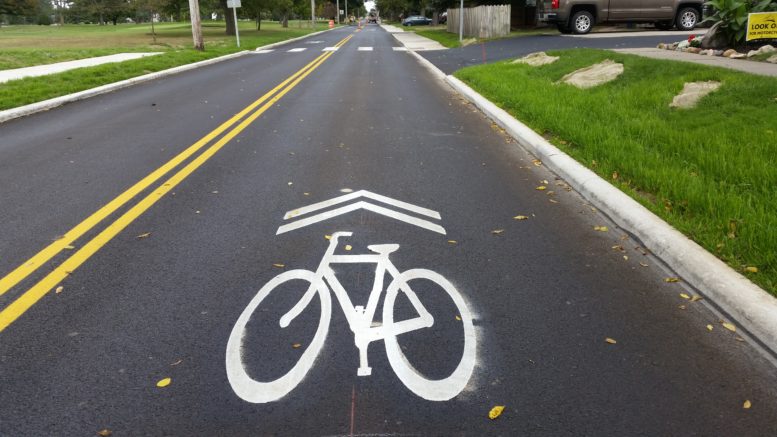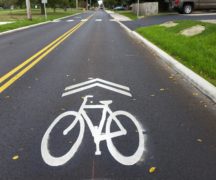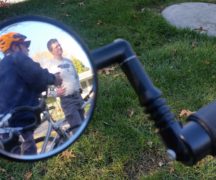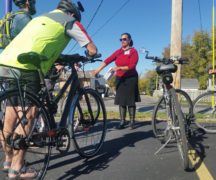By JAN LARSON McLAUGHLIN
BG Independent News
The city’s Bicycle Safety Commission peddled a report Monday evening that may result in more bike sharrows being imprinted onto pavement, and bike lanes being added to some streets.
After years of the community spinning wheels, Steve Langendorfer and his commission met with City Council’s Transportation and Safety Committee to present infrastructure that could make bicyclists more comfortable and more likely to use city streets.
The city has already worked with Yay Bikes, an education program helping bicyclists learn their responsibilities and their rights on roadways. Education is the least expensive step to encourage bicycling in Bowling Green.
“Bike riders are as entitled to the road as cars,” Langendorfer said.
However, education only goes so far – and reasonably priced and rationally prioritized infrastructure may be the next step.
Langendorfer presented the council committee with lists of city streets where sharrows would be helpful for bicyclists. Sharrows, the icons that look like bikes and arrows, have already been applied to portions of Fairview and Conneaut avenues. They are a much less expensive solution than actual bike lanes.
With fiscal and physical limitations in mind, the Bicycle Safety Commission recommended adding sharrows to the following north-south streets in the city:
- North and South Wintergarden Road, from Poe to Sand Ridge.
- North and South Maple Street, from Conneaut to Sand Ridge.
- Fairview Avenue, north of Poe (south of Poe already has sharrows.)
- North and South Grove Street, from Poe to Sand Ridge.
- North and South Church Street, from Clay to Sand Ridge, and Kenwood Avenue, from Sand Ridge to Napoleon.
- North and South Prospect Street, and/or North and South Enterprise, from Poe to Lehman.
- Thurstin Avenue, from Poe to East Wooster, and Manville Avenue, from East Wooster to East Napoleon.
- North College Avenue, south of Poe Road, and South College Avenue, from Main to Napoleon.
Sharrows were also recommended for the following east-west city streets:
- West and East Newton Road, from Community Center to North College Avenue.
- Frazee Avenue, west of North College.
- East Merry Avenue, from Thurstin to Mercer Road.
- Clay and East Ridge, from Main to Mercer.
- West Wooster Street from Wintergarden to Haskins Road.
- Clough Street, from Main to Mercer, with consideration for the curve around the windmill.
- Pearl Street, from Wintergarden to Main.
- West and East Napoleon, from Kenwood to South College.
While separate bike lanes are cost-prohibitive on most streets, the commission recommended exploring bike lanes on the following city streets, which have greater width, heavier traffic volume and higher speed limits.
“There are places where bicycle lanes will fit in the city, and we’d like to see them there,” Langendorfer said. Those streets include:
- Haskins Road, from the Community Center to West Wooster.
- Brim Road, from Newton to West Poe.
- North and South Main Street, from Newton to Gypsy Lane.
- West and East Wooster Street, from Haskins to Mercer.
- West and East Poe Road, from Mitchell to North Dunbridge.
- East Napoleon Road, from South College to South Dunbridge.
- West and East Gypsy Lane, from Sand Ridge to Klotz Road.
One last recommendation made by the commission was for a bike path linking the city to the community center on Newton Road, and a bike/hike trail on the east side of the city from Scott Hamilton Street to Carter Park.
The recommendations were met with praise from council committee members and city administration members.
“I’m impressed with the thoroughness of the study,” council member Greg Robinette said.
“I think where we’re headed is truly an excellent direction,” said council member John Zanfardino.
Other council members in attendance agreed.
“I would like to commend the work of the commission,” Council President Mike Aspacher said. “It seems like we’re moving in a positive direction.”
Council member Bruce Jeffers acknowledged the road has been long and hard – but progress is being made. “It’s hard stuff, and we’re doing the best we can.”
The next step will be for the commission to prioritize the streets for improvements – and for the city public works department to identify its road plans.
Sharrows act as an ongoing physical reminder to drivers that they must share the streets with bicyclists. But even the icons are expensive since they cost about $500 a piece and must be placed every 500 feet on the road pavement.
City officials considered the value of creating a sharrow stencil and painting the icons on using city staff. However, Public Works Director Brian Craft said the painted stencils would have to be repainted every year.
The thermo-plastic sharrows, while more expensive, last up to eight years, and are reflective at night, Craft said.
The trick for longevity, however, is to have the thermo-plastic sharrows installed within the first two years after a road has been paved. So the city will look at the bike street priorities and the paving priorities and see if any projects overlap.
Manville Avenue was paved last year, so it is a potential for sharrows.
“This report is really wonderful,” Municipal Administrator Lori Tretter said. “It’s a great example of people working together to solve a problem.”
Tretter also announced the city’s plans to work with the Toledo Metropolitan Council of Governments to repave South Main Street. The project includes plans for a bike/pedestrian path on the west side of the street from Napoleon Road to Gypsy Lane Road. The work is planned for 2024.
Robinette also stressed the need to continue working on a trail to the community center.
“We’ve got to connect the rest of the city to the community center,” he said.
Langendorfer agreed.
“We would love to have people bicycle out,” but not on fast and narrow roads, he said.
Zanfardino noted other ways to make room for bike lanes, such as removing street parking or turning streets into one-way roadways.
“There are people who ride bikes a lot who aren’t comfortable riding in Bowling Green,” he said.
But Langendorfer cautioned that those options are not only unpopular with residents, but the one-way streets often lead to faster traffic.
In order to help with their decisions, Sandy Wiechman, of Safe Communities, also presented those working on bike provisions with statistics on accidents involving bicycles in the city during the last five years.




